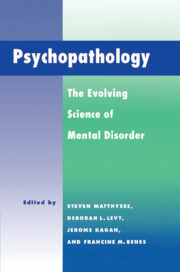Book contents
- Frontmatter
- Contents
- List of Contributors
- Preface
- Brain mechanisms
- Development
- 7 Editor's introduction: Methods in the developmental study of madness
- 8 Developmental psychopathology: From attribution toward information
- Comments on Sheldon H. White's chapter
- 9 A paradoxical partnership: Some historical and contemporary referents linking adult schizophreniform disorder and resilient children under stress
- 10 A look at the evolution of developmental models of schizophrenia
- 11 Developmental theory: Lessons from the study of risk and psychopathology
- 12 The return of the ancients: On temperament and development
- Thinking
- Genetics
- Response and reflections
- Author index
- Subject index
9 - A paradoxical partnership: Some historical and contemporary referents linking adult schizophreniform disorder and resilient children under stress
Published online by Cambridge University Press: 04 May 2010
- Frontmatter
- Contents
- List of Contributors
- Preface
- Brain mechanisms
- Development
- 7 Editor's introduction: Methods in the developmental study of madness
- 8 Developmental psychopathology: From attribution toward information
- Comments on Sheldon H. White's chapter
- 9 A paradoxical partnership: Some historical and contemporary referents linking adult schizophreniform disorder and resilient children under stress
- 10 A look at the evolution of developmental models of schizophrenia
- 11 Developmental theory: Lessons from the study of risk and psychopathology
- 12 The return of the ancients: On temperament and development
- Thinking
- Genetics
- Response and reflections
- Author index
- Subject index
Summary
Introduction
It seems paradoxical to suggest that a possible linkage may exist between adult schizophreniform disorder on the one hand and resilience in children exposed to highly disadvantaged circumstances. It is paradoxical in view of the great disparities which are so evident when contrasting the two groups: the wide age difference; the marked variations in developmental course; the striking differences in adaptability at different points in the life course, particularly the efficacious behaviors that are often characteristic of resilient children; the variation in prognoses and the likely disparities in long-term outcomes; and the marked differences in the origins and magnitude of scientific inquiry focused on each group. Particularly striking is the time period in which each group first became an object of description and inquiry. “Madness” was the original designate for the incorporative conception of schizophrenia, its study extending back to the seventeenth century. By contrast the study of resilience in children is largely a product of the closing decades of the twentieth century. Nevertheless, there exist ties whereby the contributions of a segment of a broader canvas of schizophrenia research has resulted in the identification of factors in a subset of schizophreniform patients that appear to parallel attributes of children (and possibly those of selective adults as well) who exhibit patterns of resilient behavior.
- Type
- Chapter
- Information
- PsychopathologyThe Evolving Science of Mental Disorder, pp. 200 - 228Publisher: Cambridge University PressPrint publication year: 1996
- 2
- Cited by



